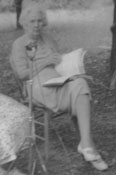 This Goodly Land
This Goodly Land
Ruby Pickens Tartt (January 13, 1880–November 29, 1974)

Other Names Used
- Ruby Stuart Pickens: birth name
Alabama Connections
- Livingston, Sumter County: birthplace, childhood residence, education, adult residence, burial
- York, Sumter County: adult residence, place of death
Selected Works
- Tartt, Ruby Pickens. "Honey in the Rock": The Ruby Pickens Tartt Collection of Religious Folk Songs from Sumter County, Alabama. Ed. Olivia and Jack Solomon. Macon, Ga.: Mercer University Press, 1991.
- Tartt, Ruby Pickens. Dim Roads and Dark Nights: The Collected Folklore of Ruby Pickens Tartt. Ed. Alan Brown. Livingston, Ala.: Livingston University Press, 1993.
- Tartt, Ruby Pickens. Gabr'l Blow Sof': Sumter County, Alabama, Slave Narratives. Ed. Alan Brown and David Taylor. Livingston, Ala.: Livingston Press, University of West Alabama, 1997.
Biographical Information
Ruby Pickens Tartt was born and raised in Livingston, Ala. When she was growing up, she liked to accompany her father on visits to his black tenants. Tartt began drawing as a child. She attended Livingston Female Academy (now the University of West Alabama) for twelve years. In 1899, Tartt went to New Orleans to spend a year studying art and English at Sophie Newcomb College in Tulane University. She also spent a year in New York City studying art. She returned home and became head of the art department at Livingston Female Academy. After her marriage to a local banker, Tartt became active in community affairs working on behalf of local area blacks. In 1926, she befriended Carl Carmer, who used some of her stories for his book, Stars Fell on Alabama, identifying her as “Mary Louise.”
In 1937, Tartt started working for the Federal Writers’ Project, a New Deal agency. She was assigned to collect spirituals, oral histories of former slaves, and folk tales. The same year, John Lomax visited Sumter County to record folk music for the Library of Congress. Tartt introduced him to local black singers and storytellers. Lomax and Tartt became friends, and he returned in 1940 and 1941 to collect additional material. In 1942, he convinced Tartt to publish some of her collected material. Three of her stories appeared in The Southwest Review in 1944. The following year, excerpts from her work appeared in Lay This Burden Down: A Folk History of Slavery, a publication of the Federal Writers’ Project. Tartt worked at the Sumter County Public Library (now the Ruby Pickens Tartt Public Library) from 1940 to 1964 and was its director for many years. Although she didn’t write after the 1940s, she continued to draw and paint. In 1961, the Montgomery Museum of Art held an exhibit of Tartt’s work. Her last years were spent in the Sumter County Nursing Home.
Interests and Themes
Ruby Pickens Tartt collected folk songs, stories, and oral histories from black residents of Sumter County.
For More Information
Please check your local library for these materials. If items are not available locally, your librarian can help you borrow them through the InterLibrary Loan program. Your librarian can also help you find other information about this author.
There may be more information available through the databases in the Alabama Virtual Library. If you are an Alabama citizen, AVL can be used at your public library or school library media center. You can also get a username and password from your librarian to use AVL at home.
Reference Books
- Brown, Virginia Pounds, and Laurella Owens. Toting the Lead Row: Ruby Pickens Tartt, Alabama Folklorist. University: University of Alabama Press, 1981.
Reference Articles
- Beidler, Philip, and Elizabeth Buckalew. "Ruby Pickens Tartt: Citizen of the World". Alabama Heritage 87. (2008): 20-26.
Reference Web Sites
- Jones, Tina Naremore. "Ruby Pickens Tartt". The Encyclopedia of Alabama. 2008. Alabama Humanities Foundation and Auburn University. http://www.encyclopediaofalabama.org/face/Article.jsp?id=h-1132.
Location of Papers
- Alabama Department of Archives and History
- Library of Congress
- University of Texas, Lomax Collection
- University of West Alabama
Photo courtesy of the Library of Congress, Prints & Photographs Division, LC-DIG-00360.
Last updated on May 30, 2008.